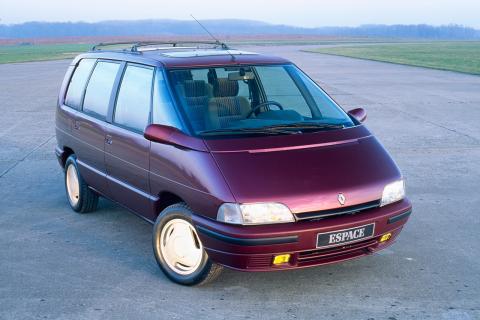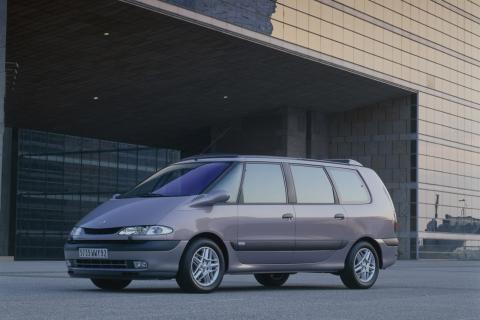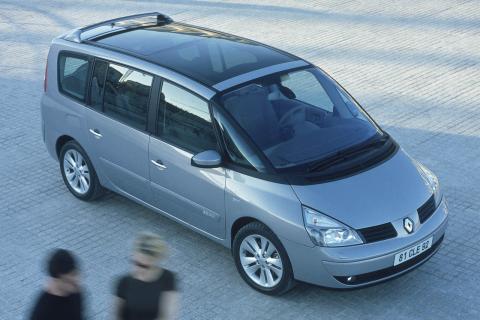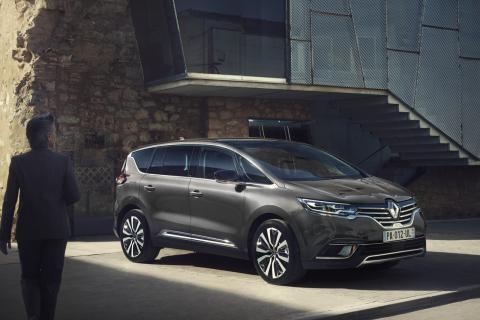
In 2023 the 40th birthday of the Renault Espace is celebrated, a model that created a school and that is now turning towards the SUV segment. Was it the first minivan in history?
Despite being a minivan, I guarantee that there is an incredible story behind the Renault Espace, which is just now going to be renewed and will become an SUV.
Although it is a well-known model, we are here to review it a bit and remember what it is like. So I reconfirm what you already know, that originally the Renault Espace was a minivan of the D segment.
To date there have been five generations of the Espace, which were presented in 1984, 1991, 1998, 2002 and 2015. Now, as the brand has already confirmed and we will tell you at the following link, the Renault Espace 2023 will be an SUV.
But look if its story has a crumb, that although it was launched in the 80s, it was actually designed in the seventies to be sold as Talbot, an English brand that I remind you was owned by Chrysler and later by Peugeot.
And behind this process there is a lot to discuss, because in this period, without a doubt, the idea of creating a minivan type vehicle arose for the first time in history and it is not completely clear if the first in history was the Renault Espace or rather the Chrysler Voyager.
I invite you to read the previous content, because it is very interesting. But I make you spoiler: in Europe the first was the Renault Espace, but the Chrysler Voyager arrived in the US a few months before.
The design of the Espace was the work of English designer Fergus Pollock, who had been working for Talbot, which was Chrysler’s British subsidiary brand, but in 1978, Talbot was sold to PSA (Peugeot/Citroën), where it was considered that the design and The high production costs of the Espace were not worth it.
These were the reasons why the first European minivan passed into the hands of Matra, who acquired the so-called Renault Project J11 and, led by Philippe Guédon, CEO of Matra, opted to make a fiberglass body mounted on a steel chassis. .
First generation of the Renault Espace 1984-1991
It all started in the spring of 1984, the date on which the first Renault Espace was finally launched on the market, sold by Renault and manufactured by Matra, whose production costs put the project at risk from the outset. In fact, it is said that only 9 units were sold in the first month…
The investment was not recovered until after two years and it was not until 1989 when it began to sell more or less notably.
Of course, its design was completely futuristic for the time, it was only 4.2 meters long and the shape of its body was reminiscent of the first TGV (French high-speed train), which was born shortly before, and was the first large family minivan. .
Renault considers it an ORNI (unidentified rolling object) and for its commercial name it broke with its strategy of using alphanumeric names at that time.
“From a semantic point of view, Espace is a very interesting word because its translation is very similar in several languages, which makes it easier for the greatest number of people to understand,” explains Sylvia Dos Santos, head of Renault names.
And he adds: “It has a soft sound, harmonious phonetics and immediately evokes comfort, enriched life on board and technology.”
At the time it was a revolution due to its great modularity: the seats were interchangeable and removable. The two front seats could be rotated to create a ‘rolling lounge’ and the five rear ones could be removed to offer a huge load capacity, which was something never seen before.
In addition, thanks to its large glass area, the interior light made the passenger compartment seem even more spacious and comfortable. Without forgetting that it offered road behavior comparable to that of a saloon and the most powerful Renault engines, which is why it was positioned as a high-end family car.
It was sold with 2.0-liter gasoline engines with powers of 100, 110, and 120 HP, as well as a 110-HP 2.2 and an 88-HP 2.1-liter turbodiesel.
It was manufactured until 1991 and 191,694 units were built. Among all of them, the versions with Quadra drive (since 1988) stood out since it was the first time that a minivan was available with all-wheel drive. Its central differential distributed traction by 65/35% between the front and rear axle.
Second generation of the Renault Espace 1991-1997
The second generation of the Espace was launched on the market in 1991 and, in addition to using the Renault 25 platform, it added to the brand image of the Renaults of the time, for which reason it abandoned the transgressive Matra design.
The 2.0 and 2.2 liter gasoline engines were maintained, as well as the 2.1 diesel; but the new platform allowed it to use the PRV engine – made by Peugeot, Renault and Volvo – a 2.8-liter V6 with 170 hp. But the strong emotions came in 1994 with the Renault Espace F1 concept, which used the Williams Formula 1 V10 engine with 820 hp.
But what is remarkable about this time is that the Renault Espace becomes a social phenomenon. The love for this concept vehicle was exponential. The name gains in notoriety while this second generation gains in maturity.
On the outside, the more rounded shapes and the mirrors integrated with the upper line of the bonnet improve aerodynamics. The interior presents a high quality and finishes refined for the time, in addition to having added new interior compartments.
Internally it was known as the Renault J63 and a total of 317,225 units were sold.
Third generation of the Renault Espace 1997-2003
With the third generation, the Espace grew in size and began to offer the Grand Espace body, which was 27 cm longer and allowed seven seats with a large trunk.
It became a segment leader of its own creation and almost, almost became a generic name that people referred to as a large minivan.
This generation is characterized by its curved design and innovative interior layout: the speedometer has been moved to the center – it uses LCD technology – and the air conditioning modules are installed on both sides of the vehicle, leaving the dashboard completely unobstructed, as you can see in the main gallery.
In 1997, the advertising slogan “What if the real luxury was space?” It continues to use the name Espace to position the model in the high-end range of Renault. In addition, this generation had the Initiale finish for the first time, which used leather and noble materials in the interior.
As far as the mechanical range is concerned, it expands the engines offered. It continues to bet on 2.0-liter gasoline blocks with 115 CV, but a 16V version with 140 CV is introduced and the top of the range at this time is a 3.0-liter 190 CV.
In diesel, the range is renewed with a 1.9 dTi of 98 CV and the dCi blocks with powers of 115 and 130 CV are introduced for the first time.
Internally it was known as Renault JE0 and a total of 365,323 units were sold.
Fourth generation of the Renault Espace 2003-2015
It could be said that its design makes a turn towards the origins of the model and returns to very geometric shapes and not so rounded, to adapt to models that the diamond brand presented at this time, such as the Vel Satis and the Avantime.
It was the first model of the Espace designed and built entirely by Renault, since all previous versions were assembled at Matra’s Romarantin (France) factory and this was manufactured in Sandouville (France) together with the Laguna and Vel Satis.
It had wider tracks and larger exterior dimensions, it was still offered in two versions, 5 and 7 seats, and it stood out for being the first minivan to achieve 5 Euro NCAP stars.
Other elements that defined it were the independent sliding seats and comfort and safety systems such as the automatic parking brake, panoramic electric roof and hands-free Renault card. Without forgetting its most luxurious ‘Initiale Paris’ finish, which it equipped with a 2.16 m² glass roof and managed to create a large living space.
The mechanical range consisted of three 2.0 16V gasoline engines, a 2.0 turbo and a 3.5-liter V10, with powers from 136 to 241 HP. And in diesel they were the 1.9 dCi, the Espace 2.2 dCi and 3.0 dCi with powers of 120, 150 and 177 CV. Later came the 2.0 dCi with 130, 150 and 173 CV.
Internally it was known as the Renault J81 and a total of 372,692 units were sold.
Fifth generation of the Renault Espace 2015-2023
The current Renault Espace was unveiled at the 2014 Paris Motor Show and, while still a minivan, was presented as a 7-seater crossover with each passenger having their own space.
The equipment is highly technological, including a large touch screen, multi-sense driving modes and 4Control, the four-wheel steering system. But as it is still for sale, we leave you the test of the Renault Espace 2015 and so you can know all the data.
After 40 years of life, the Renault Espace continues to evolve and innovate to continue nurturing its incredible history. In total, 1,345,000 units of all Espace generations have been produced in all this time.
The brand promises that in its sixth generation, although it will become an SUV based on the new Renault Austral, it will remain faithful to its DNA, its historical qualities, its vocation as a family vehicle so that the meaning of its name continues to be Espace.





